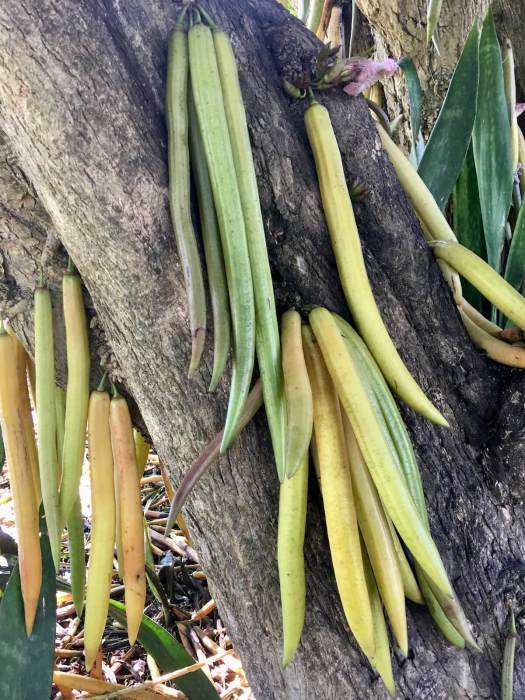
My first and only sight of candle fruit hanging from a tree was at the Fruit and Spice Park in Redland, Florida. Their Parmentiera cereifera, a biggish, branching tree, frankly amazed me.
Flowers sprouted direct from the trunk and branches, held close to the tree on stalks no longer than the flowers themselves. They were like pale green ballroom dresses with burgundy veins, looking delicate but rather strange against the bark.
All the tree’s energy seemed to go into producing hundreds or perhaps thousands of candle-like fruits that dangled in clusters where the flowers had appeared. The fruits’ skins were smooth and almost waxy and their colour, pale green, ripening to yellow. Downwards facing flowers were still being produced even though the tree was amply covered in fruit when we were there in early January 2019.

Parmentiera cereifera is more commonly known as the Panama Candle Tree. Its natural home is in high rainfall forests in the tropics where it will grow quickly and fruit abundantly. The fruits are sweetish, bland but fibrous so they are often fed to cattle, but can also be eaten raw or cooked, made into pickles and preserves. Candle fruit looks mid way between a yellow carrot and sugar cane in cross section, though sliced lengthways they are more like a narrow gerkins, 30 cm (12″) or so long.
The Fruit and Spice Park has dedicated 37 acres to growing exotic fruit, spices, vegetables and herbs. Visitors are encouraged to sample fruit from a selection in the small visitor centre and can also eat fallen fruit as they walk around, appetites permitting. My favourite new fruit was Cas, a Costa Rican guava (Psidium friedrichsthalianum).





very interesting. i’ve never seen like it before. thanks for sharing 🙂
It is one of the curious and curiouser ones. 🙂
Such an interesting tree and your description is great as well as your marvelous images.
Thank you! It isn’t one you can just share without giving a bit more detail.